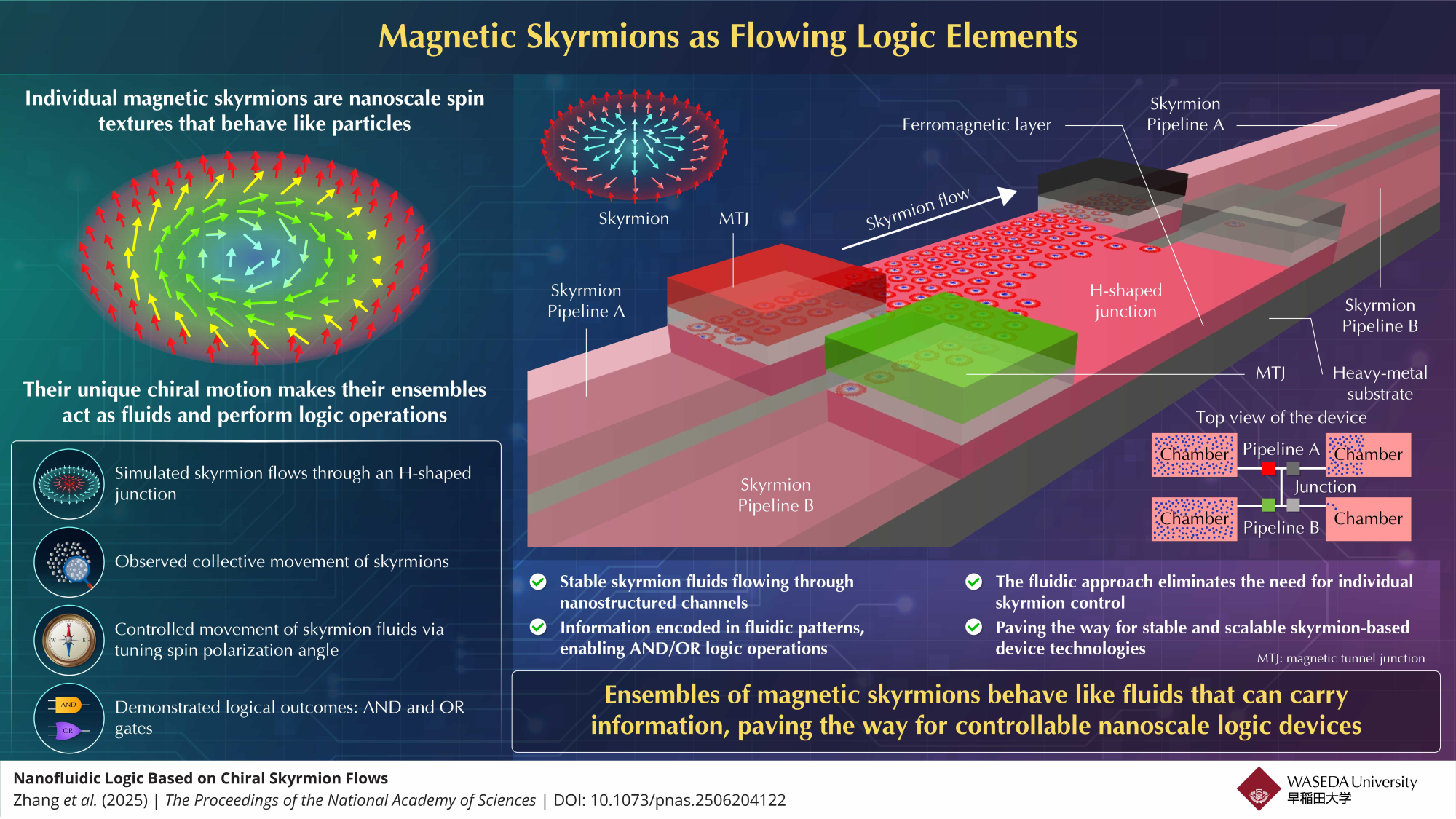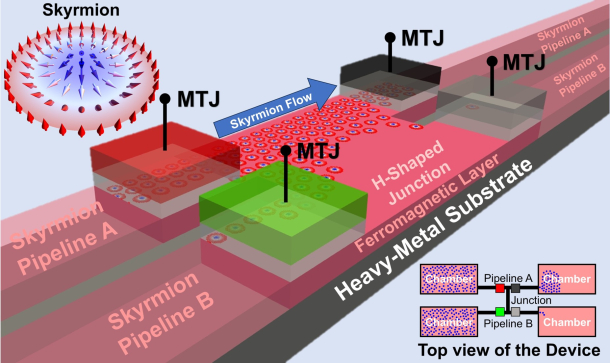New Study Suggests Chiral Skyrmion Flows Can Be Used for Logic Devices
Tue, Nov 18, 2025-
Tags
New Study Suggests Chiral Skyrmion Flows Can Be Used for Logic Devices
Waseda researchers find that magnetic skyrmions can behave like chiral fluids, which may be harnessed for fluidic logic in nanofabricated devices
Magnetic skyrmions are particle-like objects that can be used as information carriers in memory and computing devices. Researchers from Waseda University recently studied the flow behaviors of many skyrmions in structured magnets and found that skyrmions can behave like chiral fluids. They proposed that fully developed skyrmion flows can be used for fluidics, which significantly reduces complexity of skyrmion logic, as it eliminates the need for deterministic creation, precise control, and detection of individual skyrmions.

Image title: Magnetic Skyrmions as Flowing Logic Elements
Image caption: Schematic illustration showing how nanoscale magnetic skyrmions flow through an H-shaped junction to perform logic operations. The device demonstrates fluid-like collective behavior of skyrmions in tiny magnetic channels, enabling controllable nanoscale computing.
Image credit: Professor Masahito Mochizuki and Assistant Professor Xichao Zhang from Waseda University, Japan
License type: Original content
Usage restrictions: Cannot be reused without permission.
In magnetic materials with antisymmetric exchange interactions, novel particle-like spin textures called magnetic skyrmions can appear and be manipulated by electrons. First observed in 2009, they have been created and controlled at room temperature in many materials. Skyrmions, as nonvolatile information carriers, are key in electronic and spintronic devices. Their size can be just a few nanometers, enabling high storage densities. They require low current to move, are topologically stable, and offer nonvolatility and radiation hardness for extreme environments.
Over the past decade, most published reports in the field, both experimental and theoretical, have focused on the applications of individual isolated magnetic skyrmions. The main reason is that people aim to leverage the nanoscale size of a single magnetic skyrmion. However, isolated magnetic skyrmions are nanoparticle-like objects, like water molecules, which are extremely difficult to manipulate precisely. Consequently, the realization of skyrmion-based memory and logic has remained a significant challenge since the first observation of magnetic skyrmions in 2009. Particularly, fundamental operations for isolated-skyrmion-based logic computing, such as the precise duplication of a single skyrmion into two skyrmions as well as the merging of two skyrmions into one, are extremely difficult to achieve in experiments.
Recently, a collaborative group of scientists, led by Professor Masahito Mochizuki from the Department of Applied Physics at Waseda University and including Assistant Professor Xichao Zhang from Waseda University, has investigated the fluid behaviors of many magnetic skyrmions flowing in nanostructured devices. This study was published in Volume 122, Issue 44 of the Proceedings of the National Academy of Sciences of the United States of America (PNAS) on October 31, 2025.
In this study, researchers report a transformative approach for realizing skyrmion logic based on fluidic principles, that is, the world’s first logic gate based on chiral skyrmion flows. They demonstrated through computational simulations that magnetic skyrmions can be easily manipulated and function like water flowing in nanofluidic channels, which significantly reduces the complexity of skyrmion-electronics technology. In nanoscale devices, controlling the flow of water is significantly easier than controlling an individual water molecule; the same holds true for particle-like skyrmions. The scientists proposed that the information is carried by fully developed flows of fluid-like skyrmions, rather than by individual skyrmions. They demonstrated that some basic logical operations can be realized based on interacting flows of skyrmions.
The nanofluidic logic based on flowing skyrmions eliminates the need for deterministic creation, precise control, and detection of a single skyrmion in device operations. In principle, the thermal stability and annihilation of skyrmions will also cease to be a major concern in fluidic logic due to the dynamic supply of skyrmions from input ports. Additionally, there is no need to erase, recreate, or duplicate a single skyrmion in fluidic logic gates. The information carried by a fully developed skyrmion flow will never be lost in principle. Information can be duplicated or merged in a robust and straightforward manner via flow bifurcation or convergence.
When asked about the motivation of their work, Asst. Prof. Zhang explained, “In the 1960s, Bell Labs researchers Willard Boyle and George Smith were working on magnetic bubble memory, and they realized that electric charges are the analog of magnetic bubbles. They thus invented the charge-coupled device, that is, the CCD, in which many electrons are stored and allowed to flow in a certain direction. In fact, most commercial electronic devices rely on the manipulation of charged particle flows. Magnetic skyrmion is the magnetic bubble’s successor. They are charged quasiparticles. We believe skyrmion-based devices should also benefit from the flow behavior of many skyrmions.”
“Skyrmions, magnetic textures in magnets, are nothing more than patterns woven by atomic spins. Nevertheless, their collective behavior manifests as a fluid. Even more surprising is our discovery that such a skyrmion fluid can be utilized as a logic device. Our findings have demonstrated that the fluid behavior of skyrmion ensembles holds great potential both for fundamental science and for technological applications. At the same time, however, what we have revealed this time is only a small part of this potential. We intend to further advance our research, aiming to establish a new field of physics that may be called the hydrodynamics of nanoscale magnetic textures,” concludes Prof. Mochizuki.

Image title: Nanofluidic logic based on chiral skyrmion flows
Image caption: Schematic illustration of the nanofluidic logic gate based on many nanoscale skyrmions flowing through an H-shaped junction.
Image credit: Professor Masahito Mochizuki and Assistant Professor Xichao Zhang from Waseda University, Japan
License type: Original content
Usage restrictions: Cannot be reused without permission
Reference
|
Title of original paper: |
Nanofluidic logic based on chiral skyrmion flows |
|
Authors |
Xichao Zhang1, Jing Xia2, Yan Zhou3, Guoping Zhao2, Xiaoxi Liu4, Yongbing Xu5,6, and Masahito Mochizuki1 |
|
Affiliations |
1Department of Applied Physics, Waseda University, Japan 2College of Physics and Electronic Engineering, Sichuan Normal University, China 3School of Science and Engineering, The Chinese University of Hong Kong, Shenzhen, China |
| Latest Article Publication Date: |
31 October 2025 |
|
Journal: |
Proceedings of the National Academy of Sciences of the United States of America (PNAS) |
|
DOI: |
About Professor Masahito Mochizuki
Dr. Masahito Mochizuki is a professor at Waseda University in Japan. He received his PhD from the University of Tokyo in 2003. His area of expertise is theoretical condensed-matter physics, and his research interests include strongly correlated electron systems, multiferroics, spintronics, topological magnetism, and photoinduced nonequilibrium phenomena. He is a member of the Physical Society of Japan, the Japan Society of Applied Physics, and the Magnetics Society of Japan.
About Assistant Professor Xichao Zhang
Dr. Xichao Zhang is an assistant professor at Waseda University. He received his PhD from Shinshu University in 2018. He is interested in dynamic phenomena that occur in spintronics, magnetism, and soft-matter systems. His recent research focuses on the dynamics and functionalization of interacting quasiparticles on artificially nanostructured surfaces and interfaces. He also works on interdisciplinary problems that bridge skyrmionics with active-matter and fluid science. He is a recipient of the Waseda Research Award, the JSPS postdoctoral fellowship, and the CUHKSZ presidential postdoctoral fellowship. He is a senior member of the IEEE and a member of the American Physical Society.














